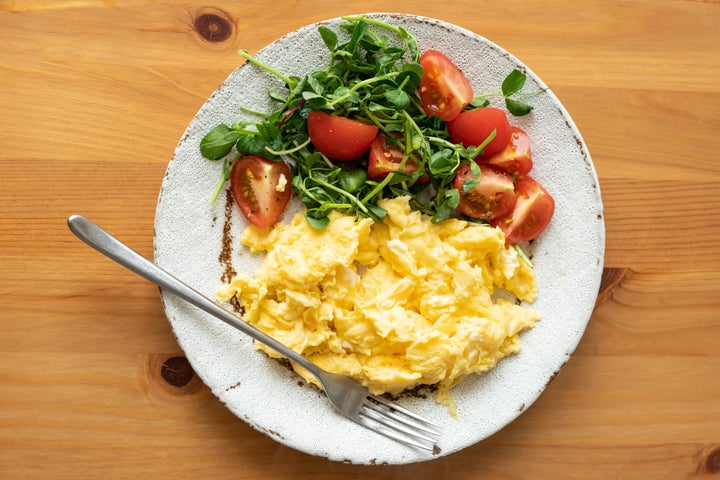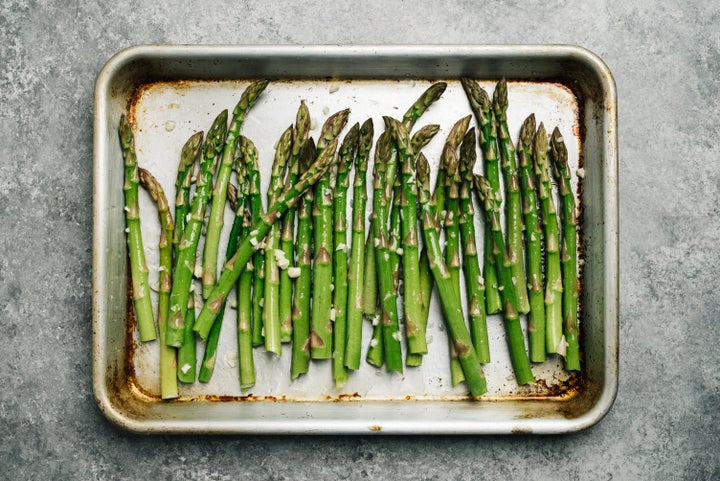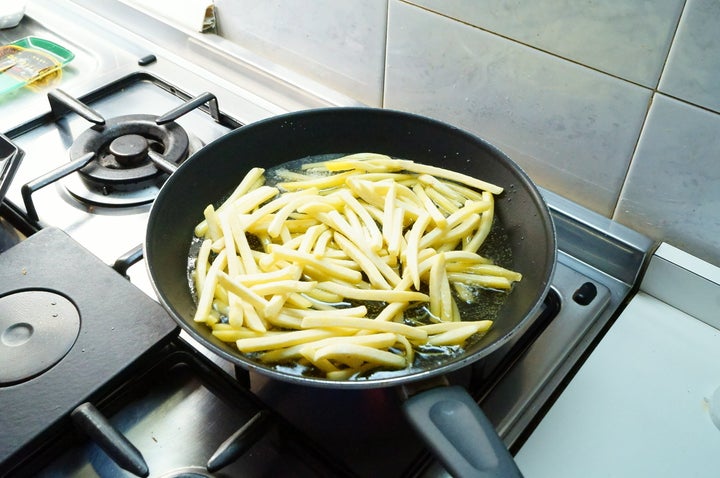
In spite of their humble reputation, leftovers can make for some truly unforgettable meals ― but only when handled correctly. Some cooked dishes actually benefit from extra time in the fridge after their flavors deepen, making the eating experience richer and more multidimensional. However, while time can work to your leftovers’ advantage in terms of flavor, texture is often the trickier aspect, and a bad reheating strategy can leave you with a dry, unappetizing next-day dish.
To help you avoid this grievous fate, we’ve asked a group of professional chefs and culinary experts for their favorite ways to reheat 10 notoriously finicky leftovers, and they’ve provided clear action steps to help you maintain both the texture and the flavor of your dish.
1. Cooked Eggs
If you find yourself with a pan full of leftover eggs after hosting a family brunch, you may be tempted to reheat that scramble (or quiche, or poached eggs) to enjoy a day later. But eggs can be a true textural challenge, especially when reheated. In fact, TV host and lifestyle influencer Leslie Antonoff advises against even attempting to enjoy leftover eggs the next day. “When it comes to eggs, reheating is NOT my thing,” Antonoff told HuffPost. “I think eggs are an eat-now type of dish. They never are as good once they’re cold. The only exception to [this no-leftovers rule] are deviled or boiled eggs; [those make] a perfect snack.”
If you’re still determined to get a second life out of your weekend breakfast, chef/educator Matthew Smith of Shaw Academy has some advice for you. “Your best bet for warming leftover scrambled eggs is simply to use a microwave-safe dish that is covered loosely with a lid,” Smith advised. “Pop the cold eggs into the dish and add a teaspoon of milk (if your eggs are on the dry side), cover loosely and microwave on high for 20 to 25 seconds. Open up and give everything a stir. If it needs more [time], pour out any liquid that has split from the egg and repeat the process until it’s hot.”
Smith also suggests a slightly more straightforward technique for rejuvenated scrambled eggs: “Pop a saucepan on medium heat. Add a good dollop of butter, and once the butter has melted, pop in your eggs and mix them around. If you have a lid for the pan, use it. Once the eggs are hot, remove from the pan.”

As for poached eggs, Smith says to “boil some water and once [it’s] boiling rapidly, gently place the cold egg into the hot water. After a minute or two, you should be ready to go.”
When it comes to omelettes and quiche, Smith has good news: “Omelettes and items like quiche are a breeze to reheat. Preheat your oven to 365 degrees F (180C). When you hear the thermostat click, it’s go time. Put your egg dish into an ovenproof dish and pop into the oven for about 15 minutes. If reheating an omelette, I would suggest covering it with some foil paper to keep any moisture in the omelette.”
2. Pizza
Plenty of pizza lovers have no qualms about enjoying cold leftover pizza right out of the fridge, but if you’re looking for a way to recapture that hot, crispy crust and melty cheese, co-founder Emily Hyland of celebrated NYC pizza spots Emily and Emmy Squared heartily recommends that you pick up an air fryer.
“I like to use an air fryer to reheat my pizza (it works especially well for Detroit-style pizza),” Hyland shared. “By using an air fryer, the pizza reheats without getting soggy (as it does in the microwave) and perfectly melts the cheese.”
Specifically, Hyland suggests air-frying the leftover pizza for 8-10 minutes. “If eating from frozen, I’d let it defrost as long as possible in the fridge before,” she said. Hyland insists that the process is “pretty foolproof! Don’t forget to put a small piece of foil at the bottom of the air fryer basket to help catch any melting cheese so it’s just a little easier to clean after. But [be] careful not to block the side air holes and always make sure to put something on top of the foil so it doesn’t get sucked up into the heating unit.”
If you don’t have access to an air fryer, try this oven method used by “Top Chef” alum Fabio Viviani: “Place [a] pizza stone or lined sheet tray in the oven and preheat to 425 degrees F. Once the oven is preheated, place the cold pizza on the warmed stone/tray and put into the oven for 4 to 5 minutes, depending on your oven. When removed, the pizza crust should be crispy with a nice crunch, and the cheese should have a nice caramelization and brown color to it.”
3. Steak
A good steak relies so heavily on the perfect texture: a juicy interior and a perfectly seared outer layer. To revive this appealing contrast in a reheated steak, chef and restaurateur Monica “Mika” Leon of Caja Caliente in Miami advises home cooks to, “on very high heat in a sauté pan, add butter and [your] piece of meat. Cook a minute or two on each side until you get the crust [on your steak], making sure to not overcook it.”
4. Roasted Vegetables
Roasted veggies can be delicious the day after they’re prepared, but food blogger Yumna Jawad of Feel Good Foodie encourages you to manage your expectations. “Unfortunately, roasted vegetables will never be as crisp after reheating as when you first roast them. But that doesn’t mean you still can’t enjoy leftover roasted vegetables! The best way to reheat them is in the oven again. My best tip would be to place the sheet pan in the oven while the oven is preheating so the vegetables hit a hot pan and benefit from more crisping in the oven. The air fryer is also a great tool for reheating roasted vegetables because they tend to get more caramelized that way, which makes any vegetable more appetizing!”

5. Cooked Pasta
When reheating cooked pasta, it’s crucial to avoid letting the pasta become gummy (which is the most common downfall of this dish). Viviani accomplishes this task like so: “Place leftover/cold pasta in a sauté pan. Heat the pan on medium to high heat. Begin to warm the pasta, adding a splash of water at a time, gradually as you stir. Add as much water as necessary to reduce the sauce, without exceeding 1/3 cup. Bring to a simmer and turn heat to medium-low, until the pasta and ingredients are hot throughout. Pasta is ready when the sauce coats the back of a spoon (ideal thickness) and pasta still has a bite to it. When reheating pasta, it may not be perfectly al dente, but it will have a nice texture without being too soft.”
6. Casseroles
Because casseroles are layered dishes, potential textural issues abound during the reheating process. According to food blogger and recipe developer Christina Musgrave of Tasting With Tina, “the best way to reheat a casserole is in the oven. Preheat the oven to 325 degrees F and cook in an oven-safe dish covered with loose foil for 30 minutes, or until the casserole is warm throughout. This will allow the casserole to slowly reheat and preserve texture, and the foil will prevent it from drying out while reheating. If you have a crispy top on the casserole and would like to maintain that texture, remove foil after 30 minutes of cooking and broil for a few minutes until the top of the casserole is crispy. But make sure your dish is broiler-safe!”
7. Cooked Seafood
Some of the chefs we surveyed warned against reheating seafood, preferring to eat leftovers cold or to simply do away with leftovers altogether. But chef Palak Patel of the Institute of Culinary Education offers a solution.
“Seafood is always at risk of being overcooked. When reheating, use gentle heat and steam to preserve the moisture and texture of the fish. I don’t reheat shrimp or scallops, and while it’s not wrong to reheat them, expect that they will be slightly overcooked. By the time smaller seafood reheats in the center, it will overcook. A little liquid (like stock) can speed up reheating. To reheat fish, place it in the center of a piece of parchment paper, add a little water, and tightly wrap it. Place in an oven at 325 degrees F for 10 minutes. Note that the time will vary depending on the thickness of the fish; the thicker the filet, the longer the reheat time.”

8. French Fries
“There’s only one wrong way to reheat French fries: the microwave,” said cookbook author and Just a Taste founder Kelly Senyei. “Ten out of ten times, microwaved fries will be soggy and lifeless.” Luckily, Senyei offered up three suggestions for reheating fries without creating a textural disaster.
First is Senyei’s oven method. “Preheat the oven to 400 degrees F. Line a baking sheet with foil and grease it with cooking spray. Arrange the fries in a single layer, then pop them in the oven for 5 to 7 minutes, or until they begin to crisp (the amount of time will depend on the thickness of your fries). Toss them once and bake them an additional 3 to 5 minutes or until they reach your desired level of crispiness.
“Second, the stovetop method. This method essentially re-fries your fries using a fraction of the oil. Rather than submerging the leftover fries entirely in boiling oil, add 2 tablespoons of neutral oil (such as canola or vegetable) to a skillet set over medium-high heat. Once the oil is hot, add the fries and toss them quickly in the hot oil so that they crisp up on all sides. Transfer them to a paper towel-lined plate and repeat the shallow-frying process with the remaining fries, adding more oil as needed. It’s important not to skip the paper towel step, as this will ensure any extra grease gets absorbed and your Day 2 fries are as crispy in texture as their Day 1 selves.”
Finally, Senyei gives a shout-out to the air fryer. “The easiest, fastest way to go from limp spuds to crunchy batons is to pop your leftover fries into the air fryer basket. Preheat your air fryer to 350 degrees F, then add the fries and cook them until they’ve reached your preferred level of crispiness, tossing the fries at the 5-minute mark to ensure even cooking on all sides,” she said.
9. Rice
You may be wondering whether the microwave is ever the way to go when reheating leftovers. If we’re talking about cooked rice, then the answer is a resounding “yes.”
“The best way to reheat cooked rice and to maintain the texture is by using a microwave,” ChihYu Smith of I Heart Umami advises. “Put the rice in a bowl and cover it with a food wrap or a microwavable lid so that the heat and moisture can circulate within the rice grains. Microwave for 1 minute, stir, and [then microwave for] another 30 seconds The rice grains will return to their original texture: fluffy and soft.”